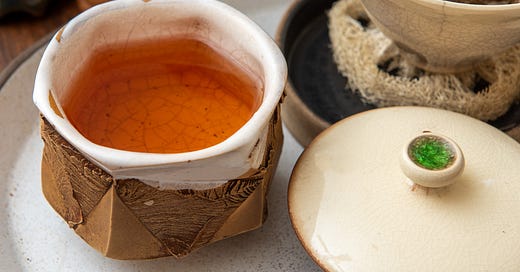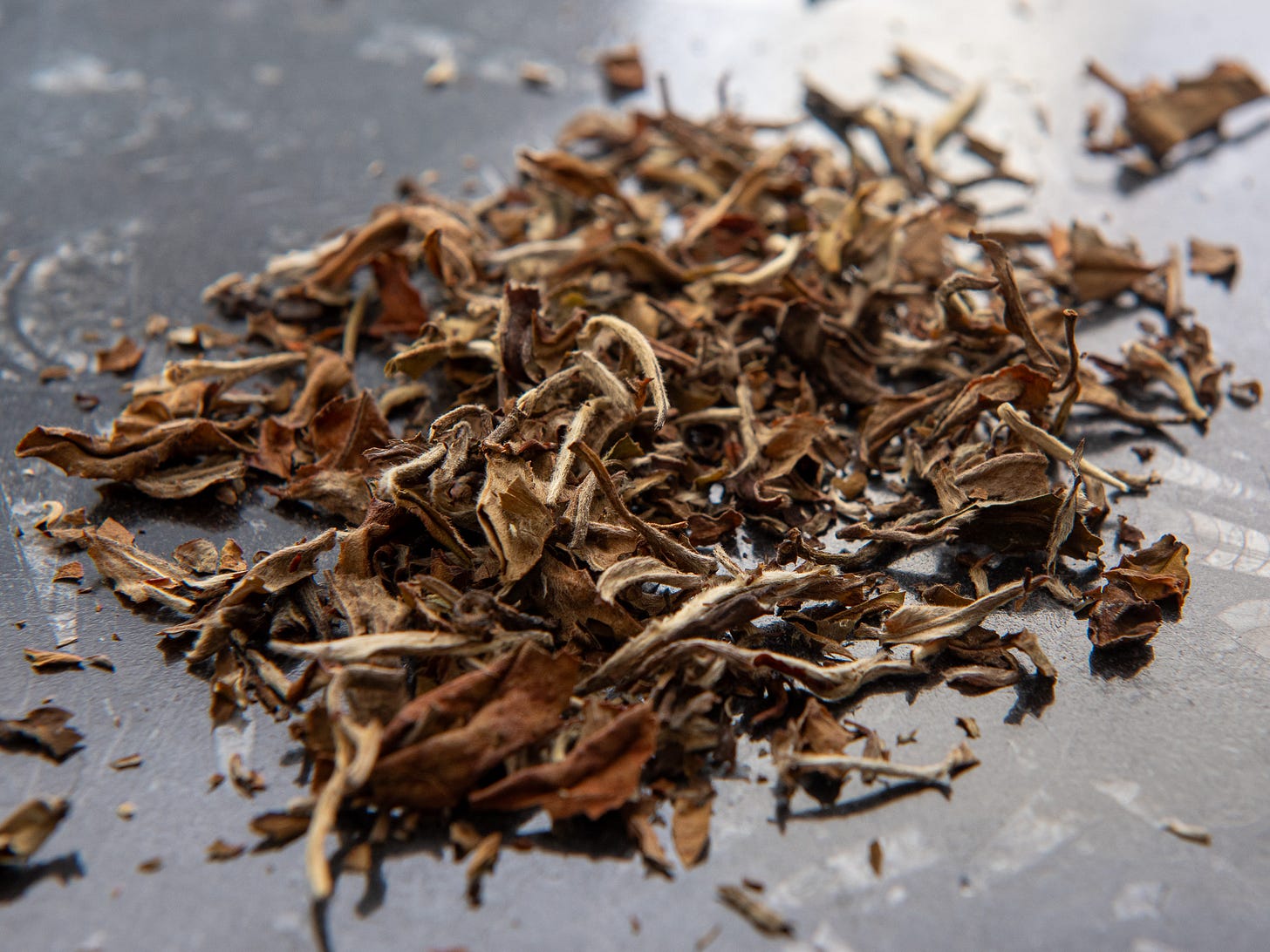There’s a kerfuffle about AI art in the tea world
An aged tea experiment + what branding signifies about a brew.
Aged white tea, beyond the usual suspects
Today’s Leafhopper is a little different. The tea I’m talking about sold out long ago, so this isn’t a purchase recommendation. Rather, I want to share findings from a tea study I’ve been running for a while.
Aged white tea is one of my favorite styles, and it’s a relatively new idea. Prior to the 2010s, white tea was usually drunk within a year or two of picking, when its fresh, creamy notes were most apparent. But some Chinese tea industry people figured out that if you store white tea well, it can age into something totally new, developing deep flavors of dates, honey, and sweet spices. Aging itself has a long history in tea, and outside of green teas, which really are best drunk fresh, most styles can be aged like wine or spirits to interesting results. Nowadays, the Chinese market is flooded with aged and “aged” versions of classic white styles like silver needle, bai mu dan, and shou mei. They’re delicious to drink, and I plan to share more on them in future installments. However I wanted to see how aging would affect white teas made elsewhere, specifically Nepal.
Like I shared a few weeks ago, Nepali tea makers are doing beautiful things with white tea. These brews share the same basic processing as teas from Fujian—China’s traditional home of white tea—though their character is distinct. They’re more crisp and airy, like a light Darjeeling, occasionally with surprising savory flavors. All white teas are made by withering fresh leaves in open air until they naturally dehydrate. Since the leaves don’t experience high heat in processing, the enzymes that cause oxidation (which is what is used to make oxidized styles like oolong and black tea) remain active. Over the years, these enzymes continue to act in slow motion, gently oxidizing the tea into a richer version of itself. At least in theory. Just because a style of tea can age well doesn’t mean a particular tea will. You can’t age a bad tea into a good one, and there’s no guarantee that a good fresh tea will taste good after aging.
In 2016, I bought half a pound of Nepali white tea from Simpson & Vail, a tea seller based in Connecticut. The tea was composed of one bud and two leaves, the usual plucking standard for bai mu dan. It wasn’t the best white tea of my life, but I enjoyed the crisp green flavors, reminiscent of tart apple and wildflowers. I transferred the leaves to canisters with tight-fitting lids, set them in the back of my tea cabinet, and waited. I dug them out every couple years to see how they were progressing.
It’s been eight years now. If I was going by a Chinese white tea timeline, the leaves would be considered well aged at this point. You can see from the color of the leaves that they’ve certainly changed. The green tint is gone, replaced with silver and brown. When steeped, the leaves reveal olive and red hues. Something’s been happening over the years.
Unfortunately, I can’t say it’s particularly nice to drink. Good aged white tea should be potent and aromatic before you take your first sip. These leaves are dull and flat in aroma. I get a broad sense of browning apple slices along with hints of plum blossom and peach. But it’s all toned down. Instead of aged, the leaves just smell old.
The taste of the brew is intriguing. Lower dosages yield an amber color and a gentle almond flavor. When I fill the pot one third of the way with fluffy leaves, I get a deeper rose color and more peach nectar on the finish. Crispness has transformed into briskness, akin to a light black tea. A pleasant sweetness lingers once the tea is gone. I get better results with cooler water, around 80 or 90°C (176 to 194°F). Boiling water—typically used for aged whites—extracts more astringency than I like.
Overall I’d say this tea is fine. I wouldn’t serve it to friends and I’d rather drink from my stockpile of Chinese aged whites. It could be that this particular batch just wasn’t going to age well. Or differences in processing and leaf type may mean that it takes longer to age than its Chinese cousins. I have one bai mu dan that took more than ten years to age into something good, rather than adolescent and awkward, and now it’s really good. I’m going to keep aging this batch and see what happens. I also want to set aside some superior Nepali whites to see how they fare, even if the whole enterprise winds up not working out. People have been making white tea in China for more than a thousand years. Maybe Nepali producers just need more time to experiment. It’s not like they’re intending for these teas to be aged at all—that concept remains firmly rooted in China for now.
It’s important to share our failures as well as our successes. That’s the only way we learn and discover new things. So watch this space for more experiments in the future, as well as some of my personal favorite aged whites and notes on how to age your own. This article from the TeaDB blog should get you started with good principles for quality aged white tea.
If you have some tea you particularly enjoy, why not set some aside in a tightly sealed container and forget about it for a while? When you return in a few years, you might find it has something new to say.

Is AI imagery coming for your tea?
Glen Bowers has found himself in hot water.
On Friday, the co-founder of Crimson Lotus Tea shared a new wrapper design for one of the company’s house blended puer cakes, called Gamechanger. “This is our first design to use elements created by AI,” he wrote on Instagram. “The world of AI art came upon us far faster than anyone was expecting. We created this tea to act as a spark for the discussion of using AI art for commercial products. We would love to hear your thoughts!”
Reactions were divided. “AI generation is a powerful tool, and a good artist can use it to great effect. Looks like whoever did this wrapper did a great job,” one commenter shared. However most responses were negative. “Due to the way these ‘AI’ models are trained (ripping work off the internet without creators consent),” another commenter said, “I can't get behind anything it creates, full-stop. It's a severe copyright issue that takes work from traditional artists. I am very sad to see an AI wrapper from a tea company I like so much.” Backlash has been strong enough that Crimson Lotus is now offering the tea with a plain white wrapper option, for those who want to buy the tea without the AI imagery. When I reached out to Glen for comment, he wrote to me:
For “Gamechanger” I wanted the conversation to happen on AI’s role in society. I genuinely didn’t understand how polarizing my thoughts and opinions would be. I do believe that it is possible for artificial intelligence to be used in the arts ethically. I have come to realize that what I thought were thoughts and opinions that could be shared and communicated and discussed openly have introduced hate towards Crimson Lotus Tea and I was not ready for that. Glen Bowers the artist will continue to experiment with AI generated art but we don’t plan on using any in future Crimson Lotus Tea wrappers.
I don’t want to railroad Crimson Lotus with a takedown. I like the company and think they make nice tea. The brand regularly features commissioned artwork from real human artists on their packaging, and Bowers has been transparent about which wrappers have been made with AI. He tells me this wrapper design incorporates a mix of AI and human-generated imagery, and he did his own post-processing on all parts of the design. That’s a lot more upfront than other, larger companies would be. So I want to take Glen at his word and have a conversation about AI tools in product branding, rather than pick on the little guy.
That said, as a writer and hobbyist photographer, my stance on AI imagery tools like Midjourney is that they’re plagiarism generators in urgent need of regulation. AI developers build their software by scraping artwork from across the web with no licensing or compensation to the original creators. The core of these developers’ ideology is that if you amortize that theft across millions of images, and use them to generate statistical visual averages rather than direct copies in response to human prompts, the scope of the crime is outweighed by the tool’s power and utility. Intellectual property aside, the images created by these tools is literally soulless—a regurgitation of human output absent any human intention, at a staggering computational cost. In a roundabout way, the obvious shlockiness of AI artwork reveals what’s so special about human creativity, and affirms how we recognize that creative spirit in each other.
Keep reading with a 7-day free trial
Subscribe to Leafhopper to keep reading this post and get 7 days of free access to the full post archives.







